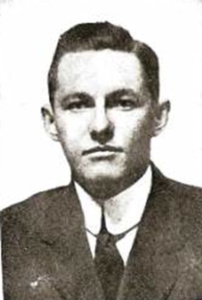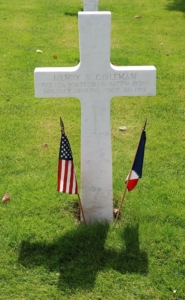Scroll of Honor – Henry Alexander Coleman
The Global Pandemic
Written by: Kelly Durham
From early 1918 to mid-1920, the Spanish Flu epidemic raged across the world, infecting 500 million people and causing an estimated 50 million deaths. The pandemic coincided with the final months of the First World War. The close living conditions of soldiers, both at the front and in training garrisons, fueled the spread of the disease.
Henry Alexander “Hal” Coleman came to Clemson from the Fairfield County rail stop of Shelton when the campus was still in its infancy. He likely arrived in the late summer of 1910 and was a member of the Class of 1914.
When the United States went to war in the spring of 1917, Coleman went too. He was an Army private first class assigned to Company C of the 306th Field Signal Battalion of the 81st Infantry Division.
The 81st Infantry Division, the “Wildcats,” was organized at Camp Jackson outside of Columbia in August 1917. The division took its nickname—and its unit patch—from Wildcat Creek which ran through its training area. The division’s soldiers were mostly draftees from the southeastern states and they became the first division in the United States Army to wear a distinctive unit shoulder patch on their uniforms.
 The division sailed for France in August 1918 and by early October, was defending a sector around St. Dié. Coleman, remembered as someone with a happy, optimistic disposition, was assigned as a switchboard operator, connecting calls between field phones linked by wires running through the trenches and dugouts scarring the battlefront. His switchboard was located in a muddy, dank, subterranean dugout. These conditions, combined with physical fatigue, probably contributed to a weakening of Coleman’s physical strength resulting in the contraction of an illness. Even so, Coleman remained at his post, continuing to facilitate the critical command and control functions between the various units of the division.
The division sailed for France in August 1918 and by early October, was defending a sector around St. Dié. Coleman, remembered as someone with a happy, optimistic disposition, was assigned as a switchboard operator, connecting calls between field phones linked by wires running through the trenches and dugouts scarring the battlefront. His switchboard was located in a muddy, dank, subterranean dugout. These conditions, combined with physical fatigue, probably contributed to a weakening of Coleman’s physical strength resulting in the contraction of an illness. Even so, Coleman remained at his post, continuing to facilitate the critical command and control functions between the various units of the division.
Eventually, Coleman’s illness reached the point where he could no longer effectively discharge his duties and he was evacuated to a hospital near Baccarat, France. His condition developed into pneumonia and he died on October 20, 1918, less than a month before the armistice that would end the war.
The end of the war did not mean the end of the dying. Soldiers returning from overseas were packed into close quarters aboard troop ships. As they were mustered out of the service, the soldiers returned home to all corners of the country, carrying the flu virus with them. More than 675,000 Americans would die from the Spanish Flu, a ratio that would equate to about 2.15 million in terms of today’s population. Clemson’s Scroll of Honor includes thirty-four heroes who died during the First World War. Of these, thirteen succumbed to pneumonia.
quarters aboard troop ships. As they were mustered out of the service, the soldiers returned home to all corners of the country, carrying the flu virus with them. More than 675,000 Americans would die from the Spanish Flu, a ratio that would equate to about 2.15 million in terms of today’s population. Clemson’s Scroll of Honor includes thirty-four heroes who died during the First World War. Of these, thirteen succumbed to pneumonia.
 Henry Alexander Coleman was buried at the Meuse-Argonne American Military Cemetery in France. There is also a marker placed in his memory at Antioch Cemetery in Fairfield County.
Henry Alexander Coleman was buried at the Meuse-Argonne American Military Cemetery in France. There is also a marker placed in his memory at Antioch Cemetery in Fairfield County.
For additional information about Henry Alexander Coleman see:
https://soh.alumni.clemson.edu/scroll/henry-alexander-coleman/
For more information about Clemson University’s Scroll of Honor visit:
https://soh.alumni.clemson.edu/
